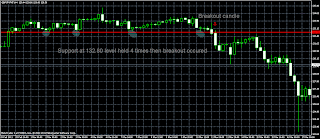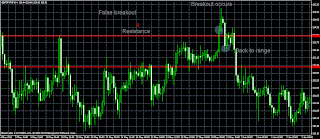Breakout is the topic of the post on the blog �Trend� today. It is a trading strategy that a lot of traders use on various times frames. Let me give you an example of a breakout trade before I speak about theoretical and practical aspects of the strategy.
What is a breakout?
Breakout is a price movement through some level (support or resistance) that held for some time, but finally increased volumes of long or short orders forced the price of a security to leave the range and go up or down. It happens when a lot of orders that are placed very close to the level are opened, or some fundamental news pushes the price out of the range.
False breakout
When the price immediately or after very short period of time comes back to its range we call is a false breakout. As very many traders apply the strategy we have a lot of false breakouts nowadays in all financial markets. This means that this trading strategy should not be your only one, unless you are able to have a large variety of filters for filtering your trades.
How to trade breakouts?
Although prices stay a lot of time in their ranges, a breakout finally occurs. Depending on the time frame you are looking at there could be from a few of them a year to a dozen a day. Trading breakouts on various time frames is based on the same principles. What works on one time frame, will work on a different time frame too.
Firstly, you have to identify high and low levels of the range the price of a security is in. These levels if you remember are called support and resistance. In a range prices move between those levels and hardly ever come out of them. However, after some period of time, range becomes smaller and smaller until prices finally thrust through support or resistance. Mark those levels while prices are still inside. Just put a trendline on support and a trendline on resistance.
When you have done this, you can immediately place a buy stop above the resistance and a sell stop below the support. This would be trading a breakout without any filters. You will have a lot of good trades and a lot of bad trades by trading this way. One filter which I like to apply (and you must have noticed it if you have been following my blog posts) is to wait for some fundamental news to push the price beyond those important levels. So, you place your buy and sell stop orders beyond the levels a few minutes before the news and wait for a breakout when news is released. If prices go through the level, you go with the market, if the market ignores the news and comes back to its ranges you remove your stop orders and continue analyzing the market and watching for other opportunities and strategies to trade.
When a security comes back to breakout level it might mean one of two things: either the breakout false or it just came to test the level. In the latter case you might add to your position and continue going in the direction of the breakout. This happens quite often!
So, I hope you can see now how you can trade break outs. Good luck in doing that. I will expand the post in the future.
Read my previous post:
Disclaimer
Trading financial markets carries a high level of risk, and may not be suitable for all investors. All information on the blog is of educational nature and cannot be considered as advice, recommendation or signals to trade in any financial markets.


No comments:
Post a Comment